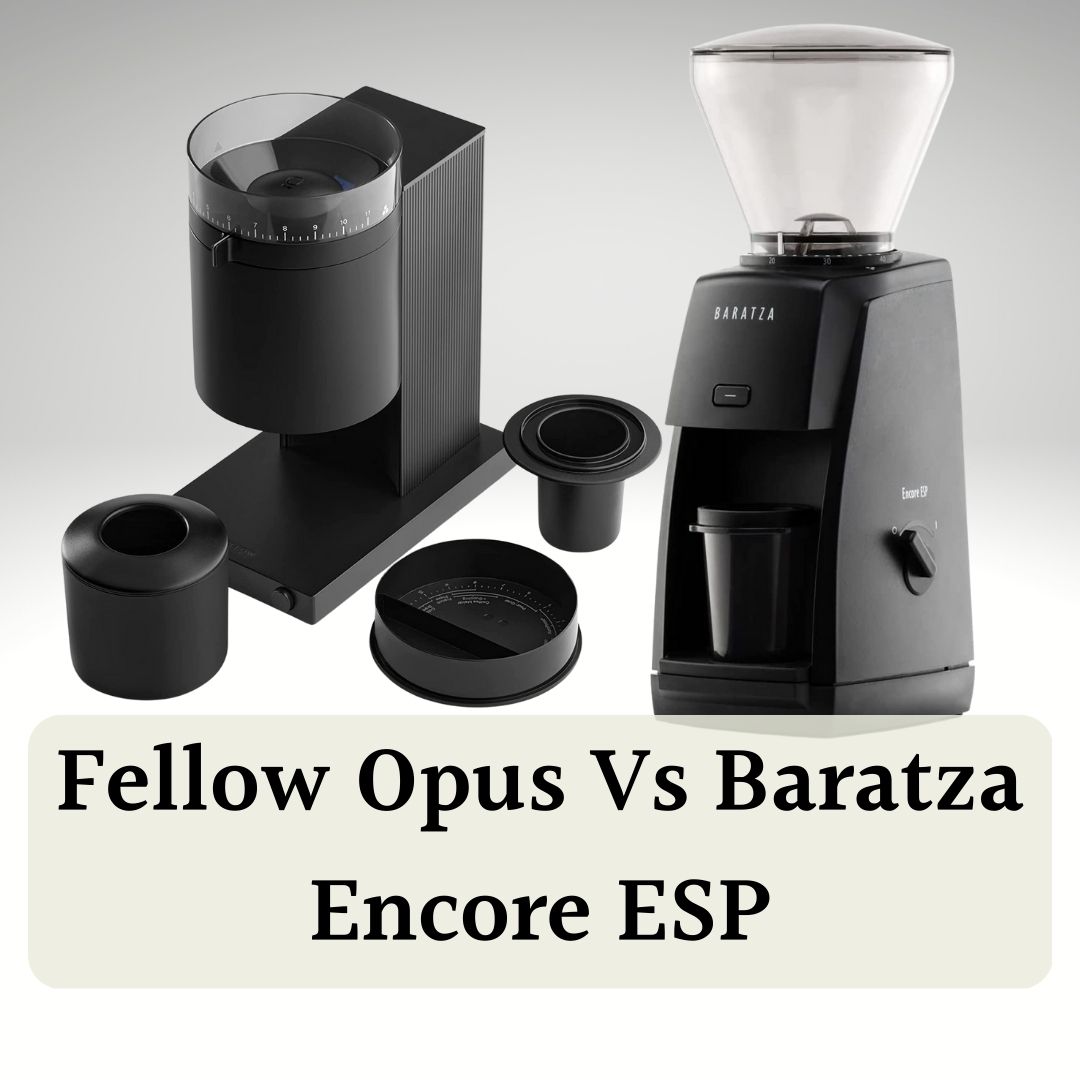The DF64 coffee grinder has taken the specialty coffee world by storm in the last two years. Its proponents claim that it offers the same value as some of the best home coffee grinders at a fraction of the price.
I’m happy to report that these claims are well-founded. I use the DF64 grinder every day for brewing espresso at home, and it consistently delivers rich, tasty shots. If you can overlook a few minor annoyances, you’ll find a reliable espresso grinder for an affordable price.

In this DF64 grinder review, I’ll go over the most exciting features of this grinder, as well as the small inconveniences worth noting. I’ll also explore how it stacks up to the closest competitors in its class.
Who Makes This Grinder?
The DF64 came out of nowhere in early 2021. It wasn’t manufactured by any of the major players in specialty coffee but still boasted some impressive capabilities.
Adding to the confusion, it goes by different names depending on where it’s bought. It’s called the G-Iota in Belgium, the Solo in the UK, and the Turin DF64 in the US. On Amazon, MiiCoffee sells the DF64. It’s manufactured under a generic name by Ningbo Frigga Electric Appliance Co. in China, and each distributor of the grinder has renamed it to resell in their country.
These brands all sell the same DF64 grinder! The Turin, Solo, and G-Iota are different distributors. Regardless of its name, this grinder packs quite the punch.
DF64 Grinder Product Overview
The “64” in the DF64’s name comes from its 64mm ITALMILL stainless-steel burrs, which are used in high-end commercial grinders too. The burrs are arranged in a flat burr setup and spin at 1400 RPM. The big burrs and high-speed motor create very consistent grind sizes for a smooth taste, particularly in espresso.

DF64 Grinder highlights:
- 64mm flat burrs
- Unimodal grind distribution
- Stepless grind adjustment
- Low retention grinder
- Dosing cup for 58mm portafilter
- Declumper inside grind chute
The iconic bellow on top of the grinder pushes out coffee retained through the burr assembly after grinding. It works as a hand-powered air pump. Pressing the bellow forces air through the burrs and out of the grinder, taking any leftover fine coffee particles with it. The bellow and angled design make the DF64 a low-retention grinder. That low retention is important because the DF64 is designed for single dosing.
The stepless grind adjustment dial grinds coarse for filter coffee and fine for espresso. The ground coffee travels through a rubber declumper before dosing into a portafilter or the included plastic dosing cup. That dosing cup will fit into a standard 58mm portafilter. This makes transferring the ground coffee from the cup to a portafilter simple and clean.
The features of the DF64 coffee grinder are even more impressive considering its low price compared to its competitors. That balance of affordability and capability has made this grinder a popular choice for home baristas.
Pros
Good grind consistency
Relatively quiet
Excellent value
Lots of modification options
Cons
Messy, especially on coarser grind settings
Difficult to read adjustment ring
High static
DF64 Grinder Feature Breakdown
Design and Build
The DF64 coffee grinder is compact and clean. It’s about a foot tall, which may be a problem with low-hanging cabinets, but its cylindrical shape is narrow and easy to fit on most counters. It looks and feels like a sturdy machine. The plastic housing covers a metal frame that gives it a surprising heft. The grinder weighs a 15 lbs due to the metal casing around the motor. It’s a heavy-duty build and feels like a grinder you’ll have on your counter for years.
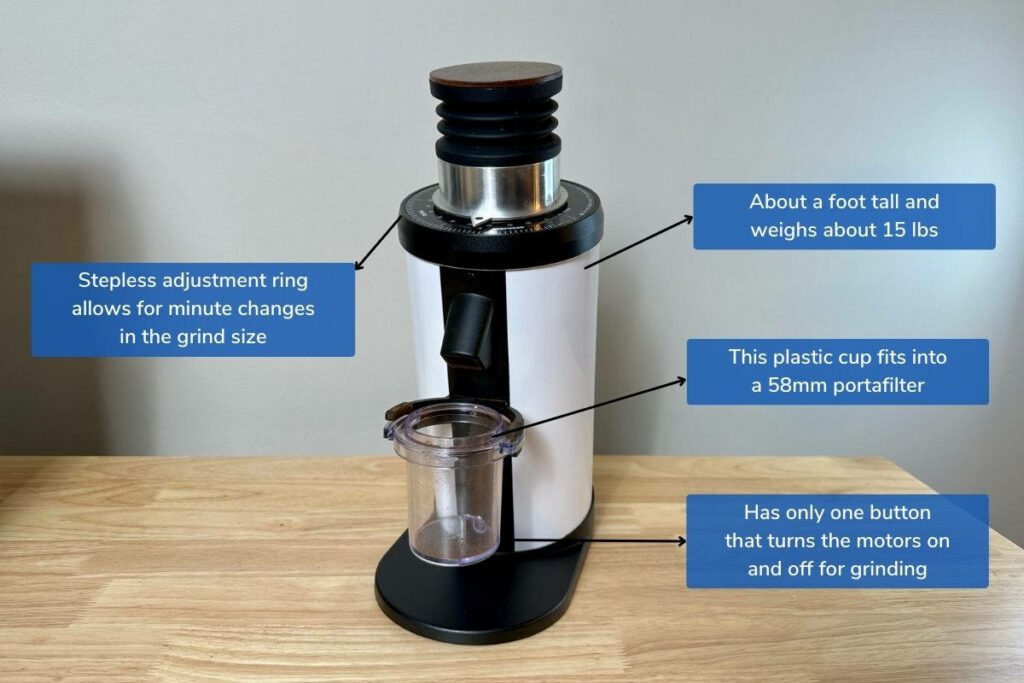
The DF64 grinder only has one button and one adjustment ring, so it’s easy to use. The “power” button is the “grind” button. When it’s plugged in, the grinder is always on (and the button light is as well). The button turns the motors on and off for grinding. There’s no programming or presets, but you don’t need them for single dosing. The amount of coffee you’re grinding needs to be weighed out before you put it in the grinder.
The stepless adjustment ring allows for minute changes in the grind size to dial in the perfect espresso. In practice, the espresso grounds range is slightly smaller than advertised on the dial. The stepless adjustments still leave plenty of room to fine-tune your grind.
There’s no clear indicator of the grind setting on DF64. There’s a little coffee bean icon on the front of the grinder, but that’s it. You can get a metal dial indicator with an arrow as a visual adjustment aid. It’s a small additional cost, but I highly recommend it.

This grinder includes a dosing cup that fits under the grind chute. This plastic cup fits into a 58mm portafilter, and the wings of the holder also fit a 58mm portafilter, so you can dose directly into a portafilter or the dosing cup. I prefer to grind straight into the portafilter, but transferring coffee to a portafilter from the cup is clean and simple.
Burr and Grind Quality
The DF64 is consistent and uniform in its grind quality and size, especially on finer grinds. It produces a unimodal grind size distribution. If you put every coffee particle on a graph based on its size, the result would be a standard bell curve. There’s one high peak of same-sized grounds. Larger and smaller grounds are distributed on either side of that peak in decreasing amounts as you get further from the average size.
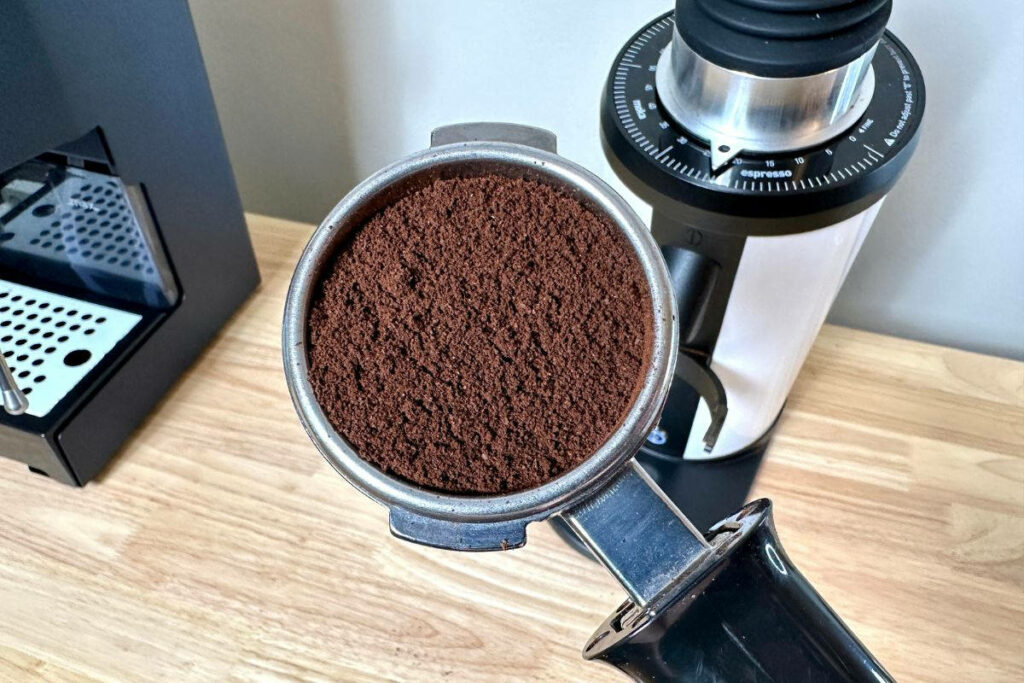
This even grind distribution leads to even extraction. This produces a smoother, cleaner flavor. Because of this, unimodal distribution creates more clarity in the brewed coffee.
This is a double-edged sword. What unimodal distribution gains in clarity, it can sometimes lose in complexity. By contrast, bimodal distribution creates a graph with two peaks, not one. This creates a wider range of extracted elements. Bimodal distribution on coffee grinders like the Sette can add body to coffee that balances its acidity.
One distribution is not inherently better than the other, but they do create very different flavor profiles. I use the DF64 mostly for espresso, so for me, the clarity that unimodal distribution creates adds a smoothness to my shots that I love.
The DF64 gets its excellent grind quality and unimodal distribution through its flat burr setup. The stock burrs on the DF64 are 64mm stainless steel flat burrs from ITALMILL. They do the job well, and the shots I pull are always crisp and sweet.
The 64mm flat burrs do allow a lot of room for customization if you want an upgrade from the stock burrs. You can order titanium-coated burrs (to improve durability) or any number of SSP burrs. The number of SSP burrs available in the 64mm size affords plenty of upgrade options beyond the ITALMILL burrs. That said, I’ve been quite happy with the ITALMILLs, and going with the stock option keeps the price in a more affordable range. ITALMILL manufactures burrs for commercial Mazzer grinders, which makes it suitable enough for me.
Note: I recommend using a WDT with the DF64, as it is prone to clumping on finer settings
Use Cases
I’ve found the DF64 to work best as an espresso grinder, but it is capable of making pour-over coffees. The grind consistency tends to get worse on coarser grind settings. It’s still fairly uniform for pour-overs but is pretty inconsistent for something like a French press.
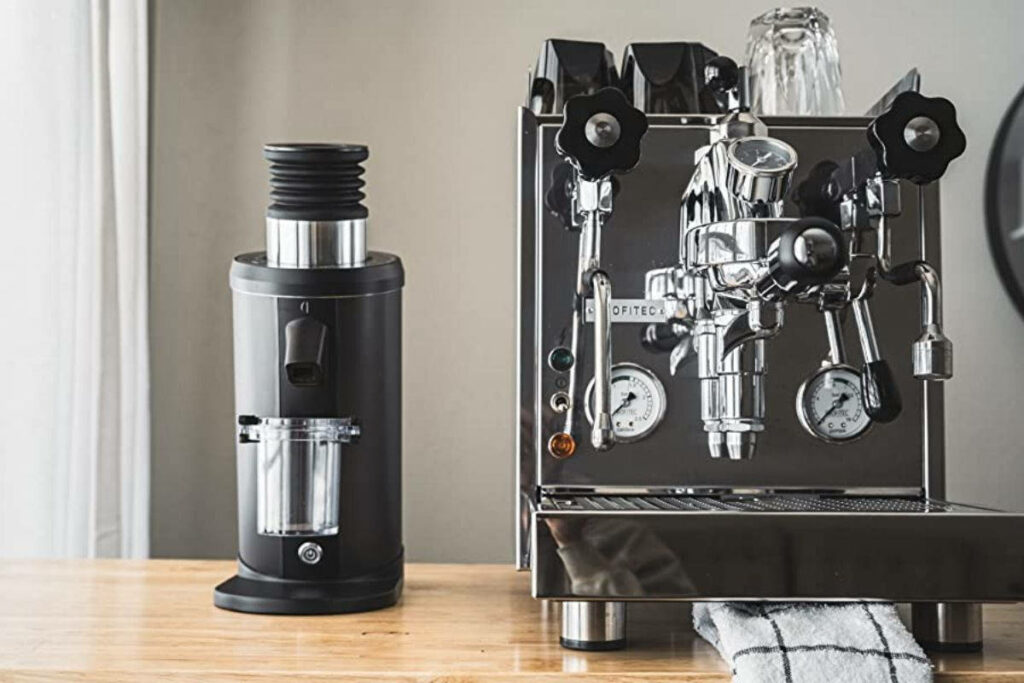
Because some uniformity is lost outside of the finest settings, the unimodal’s iconic clarity is muddied somewhat in a pour-over. It still makes for a tasty cup, but there’s a noticeable difference in flavor profile between espresso and pour-over.
The large dial is also clunky when making filter coffee. While the large dial allows you to make small changes, it requires a big turn for pour-over. Sometimes, I’d turn the dial past the max setting too, which obviously, becomes hard to measure (you can keep going more coarse and eventually unscrew the top burr, which makes for easy cleaning).
It’s also worth noting that the static build-up is much worse on coarser settings. Some coffee sticks to the grind chute when grinding fine, but the DF64 creates quite a mess on pour-over grind settings. You can fix this by spraying your beans with a little water before grinding. Without that extra step, you’ll be cleaning up your counter after every grind.
The DF64 is a capable pour-over grinder. The loss in uniform distribution and added mess make it better suited as a dedicated espresso coffee grinder.
Retention
The DF64 is a low, but not zero, retention grinder. It averages less than 1g of retention and about 0.3g of coffee exchange. So, up to 0.3g of leftover coffee from a previous dose may occasionally mix in with fresh grounds. Compared to similar grinders, 1g retention and 0.3g of coffee exchange are admirable. Some retention and exchange are unavoidable, but the retention on the DF64 shouldn’t affect the quality or flavor of your coffee. The flat burr design helps with this, but the bellow is another retention aid.
The bellow on top is a hand-powered air pump that forces air through the burr assembly. This pushes retained coffee through the grind chute. It’s a helpful tool and an unfortunately necessary one because of the declumper in the grind chute.

This declumper is a small piece of rubber between the burrs and the chute. It’s designed to reduce clumping as the coffee is ground. In reality, it’s just one extra place for coffee to get stuck in the assembly and doesn’t do much to prevent clumping. The bellow overcomes this by providing a way to push coffee through without taking the machine apart.
The rush of air through the grinder can sometimes disturb the coffee grounds in the portafilter or dose basket. This can spray grounds everywhere if you’re not careful. So, while the bellow does improve retention, it can also be an annoyance that dirties up your workspace.
Noise
The DF64 coffee grinder is quiet enough. The metal housing around the motor insulates most sound when grinding. It makes for both a sturdy and unobtrusive grinder.
The noise level also tends to be a little more shrill with less bass. It doesn’t have the chainsaw noise of the Baratza Sette, even though it’s not that far off in decibels. I find the noise manageable, and I don’t mind it in the morning (nor does anyone else in the house).
Burr Alignment
The flat burrs on the DF64 may need additional alignment out of the box. Sometimes there’s a slight difference in the angle between the top and bottom burr in flat burr grinders. A proper alignment reduces the variance in particle size when grinding, which improves consistency and extraction.
Some retailers will offer grinder alignment for an additional charge. I purchased mine through espressooutlet.net, which aligned the burrs for me. You can also watch this tutorial, which will walk you through doing an alignment yourself.
Value
The affordability of the DF64 is what makes it such a popular grinder. It rivals the capabilities of grinders that are several hundred dollars more expensive. It’s not the cheapest grinder on the market, but it is by far the most capable and impressive grinder in its price bracket.
Grinders of a similar quality to the DF64 can sometimes push $1000. The DF64, even with some additional add-ons and upgraded parts, will be a fraction of that price. There are more budget-friendly options, but you’d be hard-pressed to find a better deal for this level of performance.
DF64 Vs DF83
A DF64 grinder review wouldn’t be complete without a comparison to its big brother: the DF83. Like the DF64, the “83” in DF83 refers to the burr size – 83mm. The larger burrs grind coffee faster, but that’s not the only improvement. The DF83 is a response to criticisms of the DF64, and it fixes most of the common complaints with its predecessor.

DF83 highlights:
- 83mm Flat Burrs, which produce even more consistent grind size
- Large bean hopper
- 550W motor
It has a 550W motor, which grinds coffee much faster than the DF64’s 250W motor. The grind chute is longer, which reduces the mess produced by grinding and bellowing. The outer casing is aluminum, not plastic. These basic improvements fix some of the inconveniences of the DF64, but some problems remain.
The rubber declumper is still built into the grind chute and is still more hindrance than a help. You’ll still need a WDT to reduce clumping.
These problems aside, the DF83 is as great a value as the DF64. It’s a few hundred dollars more expensive than the DF64, but it still comes in well under $1000. You can also order SSP burrs for DF83. It’s probably not worth upgrading from the DF64 if you already have one, but it is worth considering as an alternative to the DF64.
Alternative Options To The DF64 Grinder
The DF64 is just one option for a capable home grinder. Let’s look at a few more alternatives.
Niche Zero
The Niche Zero is the closest direct competitor to the DF64. The DF64 was actually called the “Niche killer” when it first arrived. The Niche Zero offers similar capabilities but at a higher price. The Niche Zero is a conical burr grinder instead of the DF64’s flat burrs. It produces less static and has slightly better grind retention, which are products of the conical burr structure. Those burrs also create a subtle difference in flavor profile because of the different grind size distribution.
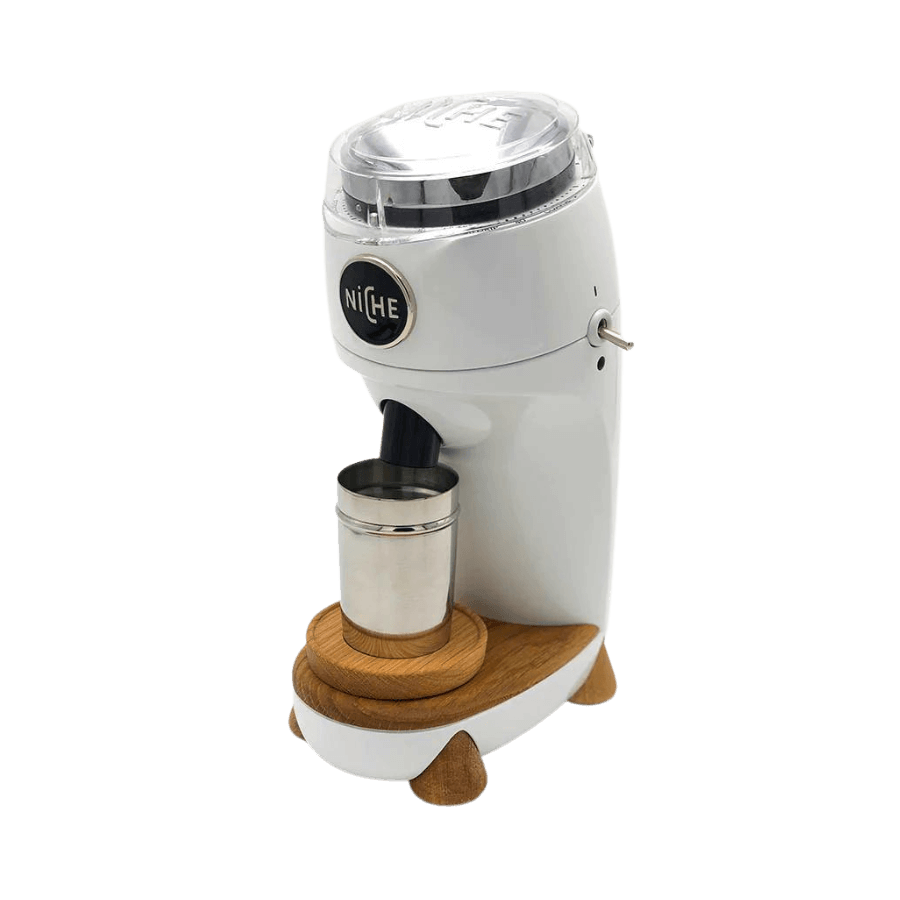
Niche Zero highlights:
- 63mm conical burrs
- Precise stepless adjustments
- Quiet, clean and simple
The Niche Zero is more expensive than the DF64, and you’re paying more for convenience than functionality. The DF64 can perform as well as the Niche, but with a little more mess and worse grind retention. The flavor profile produced by the conical burrs is different but not necessarily better than the DF64. One upgrade with the Niche is the design – it’s one of the most elegant grinders out there.
Note: The Niche Zero often struggles with supply issues that the DF64 currently doesn’t have, so it’s not as accessible as the DF64 at most retailers.
Baratza Sette 270Wi
The Sette 270Wi is different from the DF64 in almost every way. It has conical burrs, a 400g hopper, and a grind-by-weight function. It has three programmable doses.
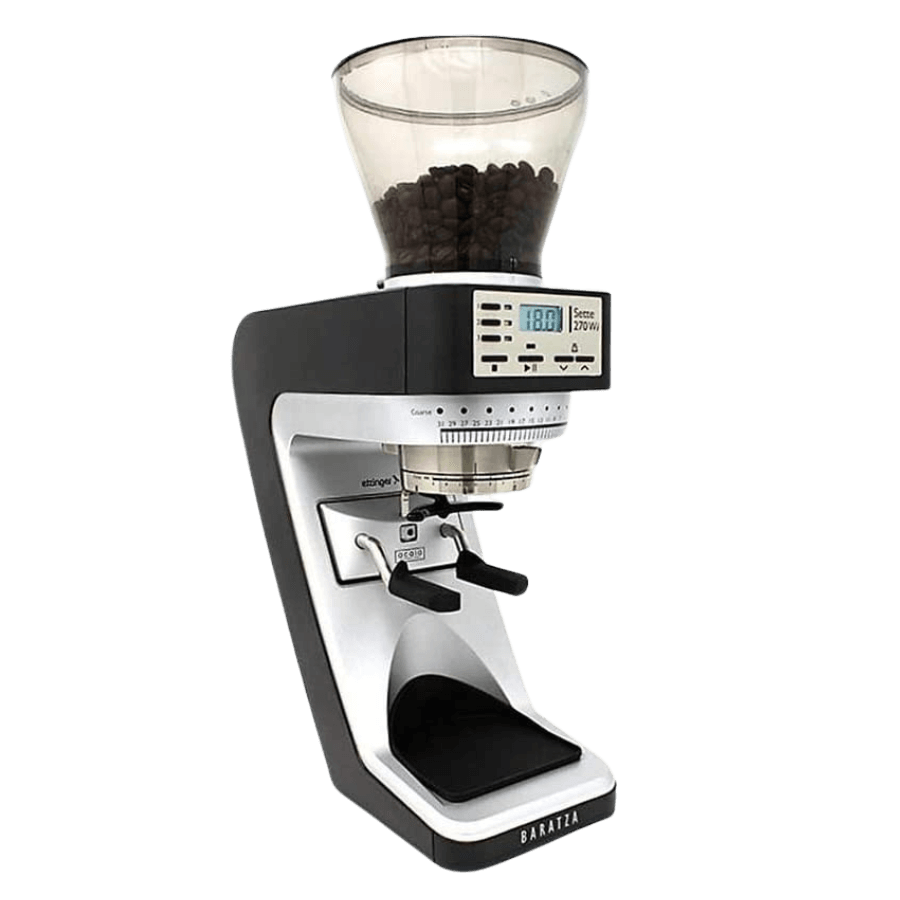
Baratza Sette 270Wi highlights:
- Three programmable dose settings
- Macro and micro adjustment rings
- Integrated Acaia scale to dose by weight
- Adjustable arms to hold a portafilter or included container
Deciding between the Sette 270Wi and DF64 is about preference more than quality. The DF64 will have better grind retention and is significantly quieter than the 270Wi. The Sette 270Wi has 270 grind settings as opposed to the DF64’s stepless adjustment. There is less ability to precisely dial-in espresso with the Sette’s controls.
However, the macro adjustment ring quickly switches between brewing methods, making the Sette far more suited to brewing both filter coffee and espresso. The programmable settings make dosing different methods easily. The Sette is also a really fast grinder, so you can easily grind 50 grams for a two-cup pour-over coffee in the morning. But be warned, the Sette is loud.
Overall, the DF64 is a better option as a dedicated espresso grinder, but the 270Wi is more versatile.
Should You Get the DF64?
I recommend the DF64 if you’re primarily brewing espresso. It’s consistent and creates a sweet, crisp, and smooth shot. It works for the occasional pour-over, but adjusting between fine and course settings can be cumbersome.
The price of the DF64 is hard to beat for the performance you’re getting. Even the upgraded DF83 with SSP burrs is still several hundred dollars cheaper than high-end espresso grinders. Inconveniences around static and cleanliness are outweighed by its extraordinary value and consistent unimodal grinding.
There are better options if you switch up brew methods regularly. That said, the DF64 is hard to beat as a dedicated espresso grinder.
The DF64 is a great budget combination with espresso machines under $500.



